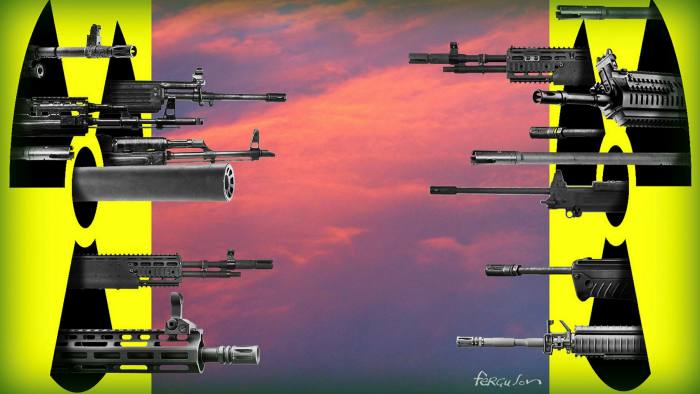Countries with nuclear weapons are moving closer to military confrontation
Gideon Rachman

© James Ferguson/Financial Times
My generation grew up in the shadow of a possible nuclear war. I was born a few months after the Cuba missile crisis — the closest humanity has come to nuclear Armageddon. The Campaign for Nuclear Disarmament was a big political force as I was growing up.
My children’s generation are much more likely to demonstrate against climate change than nuclear weapons. Leading politicians also no longer worry so much about nukes. Nuclear arms-control negotiations, a staple of the cold war, have fallen into abeyance.
But this relatively relaxed attitude is having a paradoxical effect. It seems to be making countries armed with nuclear weapons more willing to risk military confrontation with each other.
There are three international rivalries where tensions between nuclear-weapons states are reaching dangerous levels. The biggest current risk is on the China-India border — where recent clashes have led to 21 Indian fatalities and an unknown number of Chinese casualties.
Military tensions are also rising between China and the US in the Pacific. Meanwhile, the crisis in Belarus has led to fears of Russian military intervention, which would put Nato on alert.
The erosion of nuclear deterrence gives rise to two distinct, but related, risks. The first is of a conventional war, which could happen if two nuclear-weapons states believe they can fight each other without the risk of nuclear escalation. The second is of a nuclear war, which could happen if a conventional war escalated unexpectedly.
During the cold war, the US and the USSR were too conscious of the dangers of nuclear warfare ever to risk striking each other directly with conventional weapons. But the Chinese leadership has taken the risk of killing Indian troops, despite India's possession of nuclear weapons — and New Delhi is pushing back.
The deadly clash in the Himalayas over the summer was only the second time that two nuclear-weapons states have fought. The first was the Kargil war between India and Pakistan in 1999.
That confrontation did not go nuclear. But it left world leaders profoundly shaken. Bill Clinton, the US president at the time, called the frontline where the two sides had clashed “the most dangerous place in the world”.
There are fewer nuclear-alarm sirens sounding this time around. Most experts take comfort from the fact that India and China both have a policy of “no first use” of nuclear weapons. But if Beijing and New Delhi’s confidence that the other side will not use nuclear weapons persuades China to press home its military advantage, then India may be tempted to alter its policy in an attempt to restore deterrence. Some experts point to the possibility of India deploying tactical nuclear weapons in the Himalayas, or formally renouncing its no-first-use policy.
Threatening to use nuclear weapons is always tempting for a country that fears it might lose a conventional war. Pakistani military doctrine envisages an early resort to nuclear weapons, in the event of an invasion by India that would otherwise lead to defeat.
Western analysts have long feared that, for similar reasons, Moscow will threaten to use nuclear weapons early in any conflict with Nato. This strategy is known as “escalate to de-escalate”. Nato planners sometimes point to a 2009 Russian military exercise that reportedly ended with a simulated nuclear attack on Warsaw. The Russian scenario was centred around a conflict over Belarus — where current civil and political unrest has led to discussion of Russian military intervention.
American concern that Russia might use smaller, tactical nuclear weapons, in any conflict with Nato has led the US to develop its own new generation of low-yield nuclear weapons. These were deployed for the first time on submarines earlier this year. They are said to be smaller than the bomb that devastated Hiroshima in 1945 — an idea that is apparently meant to be reassuring.
As well as modernising its nuclear arsenal, the US is withdrawing from its existing nuclear-arms control agreements with Russia. The Intermediate Range Nuclear Forces treaty was allowed to lapse in 2019. The Start treaty, which governs intercontinental nuclear missiles, is unlikely to be renewed next year.
A major reason that the Trump administration has given for not renewing existing arm-control treaties with Russia is that they do not limit China — which is the country the US now regards as its most dangerous rival.
Even when Barack Obama was president, I heard senior American strategists predict that there will eventually be a military confrontation between the US and China — probably at sea. Their expectation was that any confrontation would be quickly brought under control through diplomacy.
The risks of such a clash are now rising, with Washington and Beijing taking actions over Taiwan and the South China Sea that the other side regards as provocative. The obvious danger in a clash is that diplomacy fails to calm things down and the conflict escalates.
The fact that any confrontation would be seen as a symbolic struggle for primacy in the Pacific means a clear defeat might well be unacceptable to both Beijing and Washington. That increases the risk of military escalation between two states that possess considerable nuclear arsenals. No one should be complacent about how that might play out.
0 comments:
Publicar un comentario